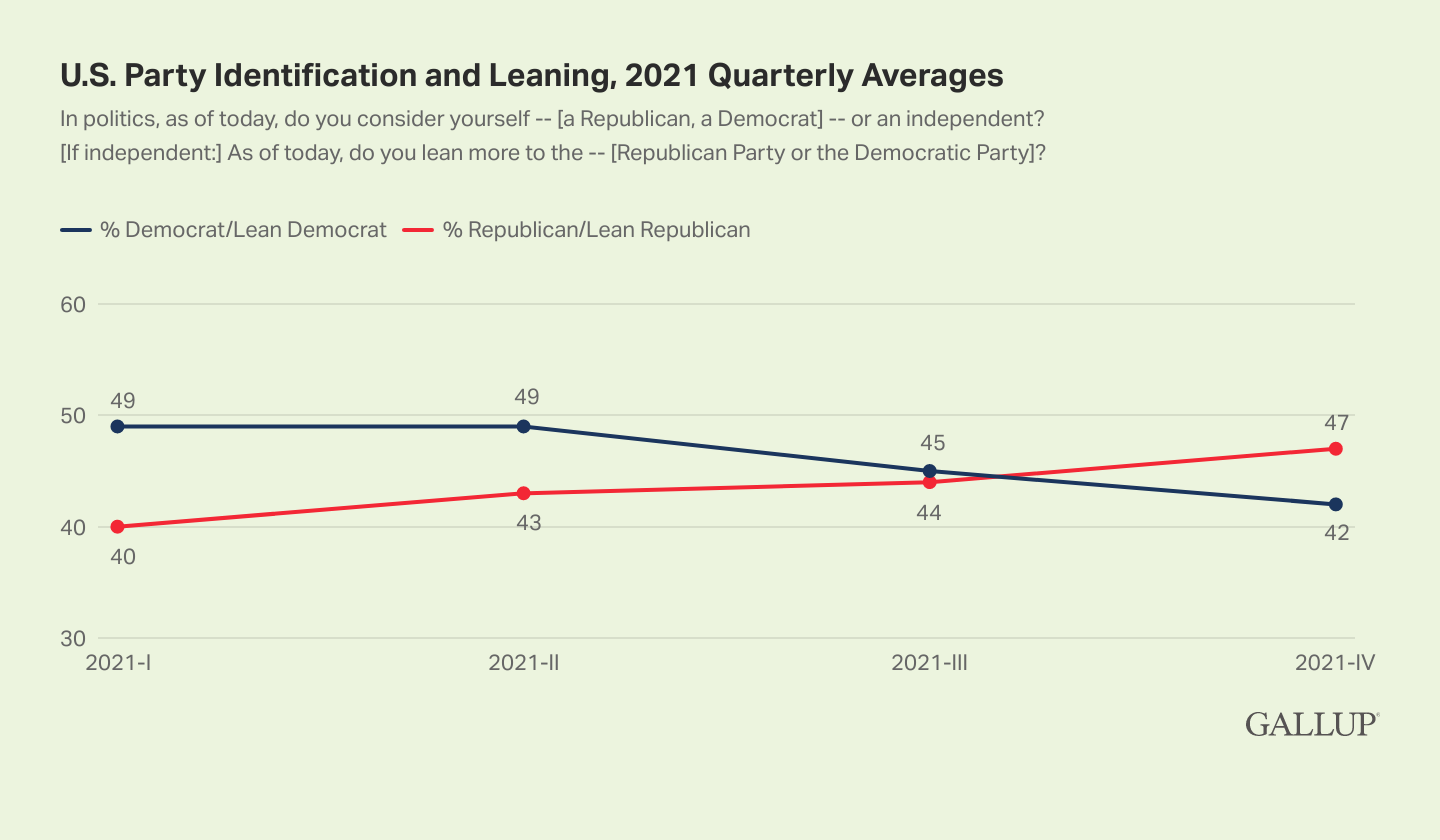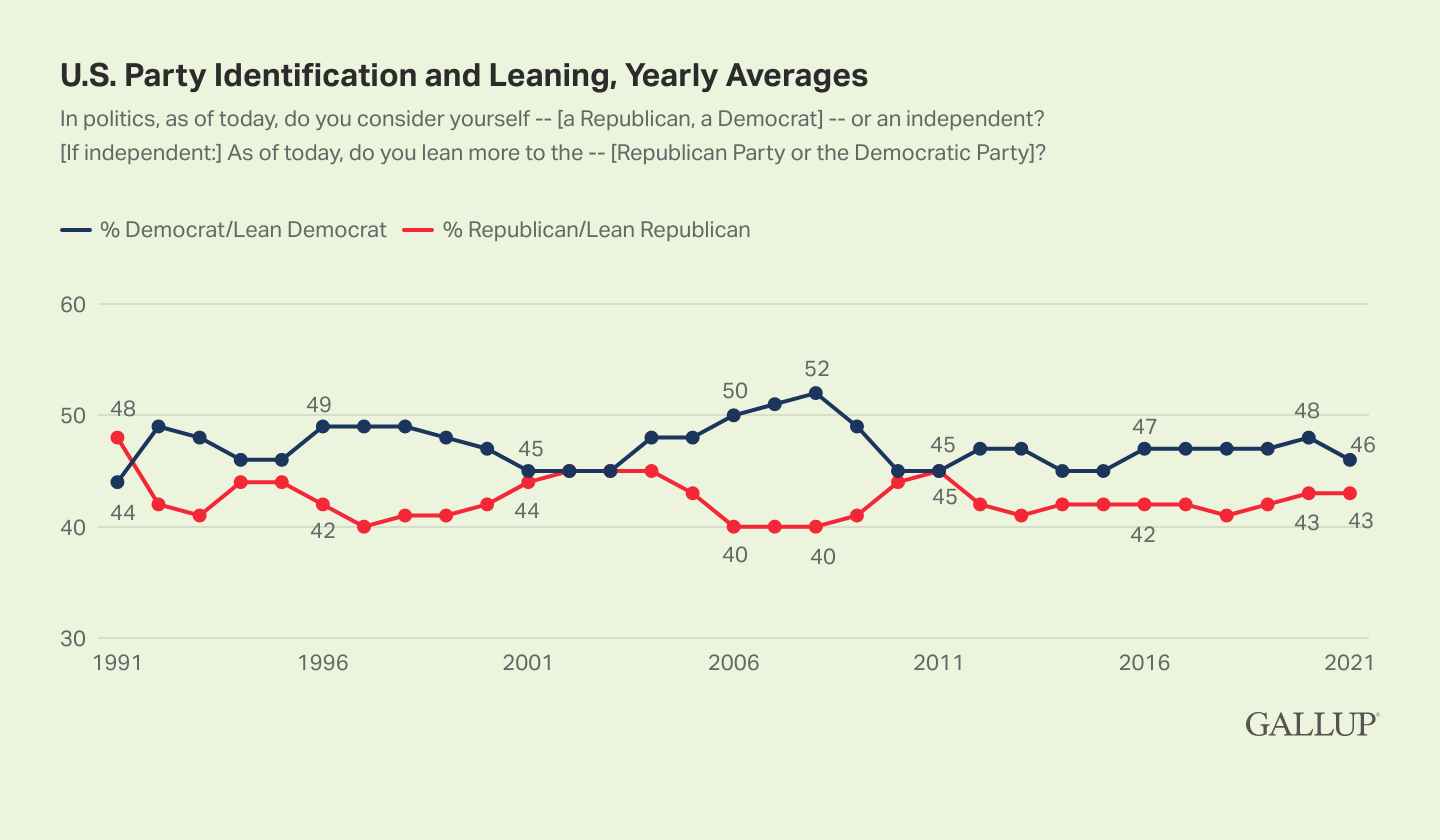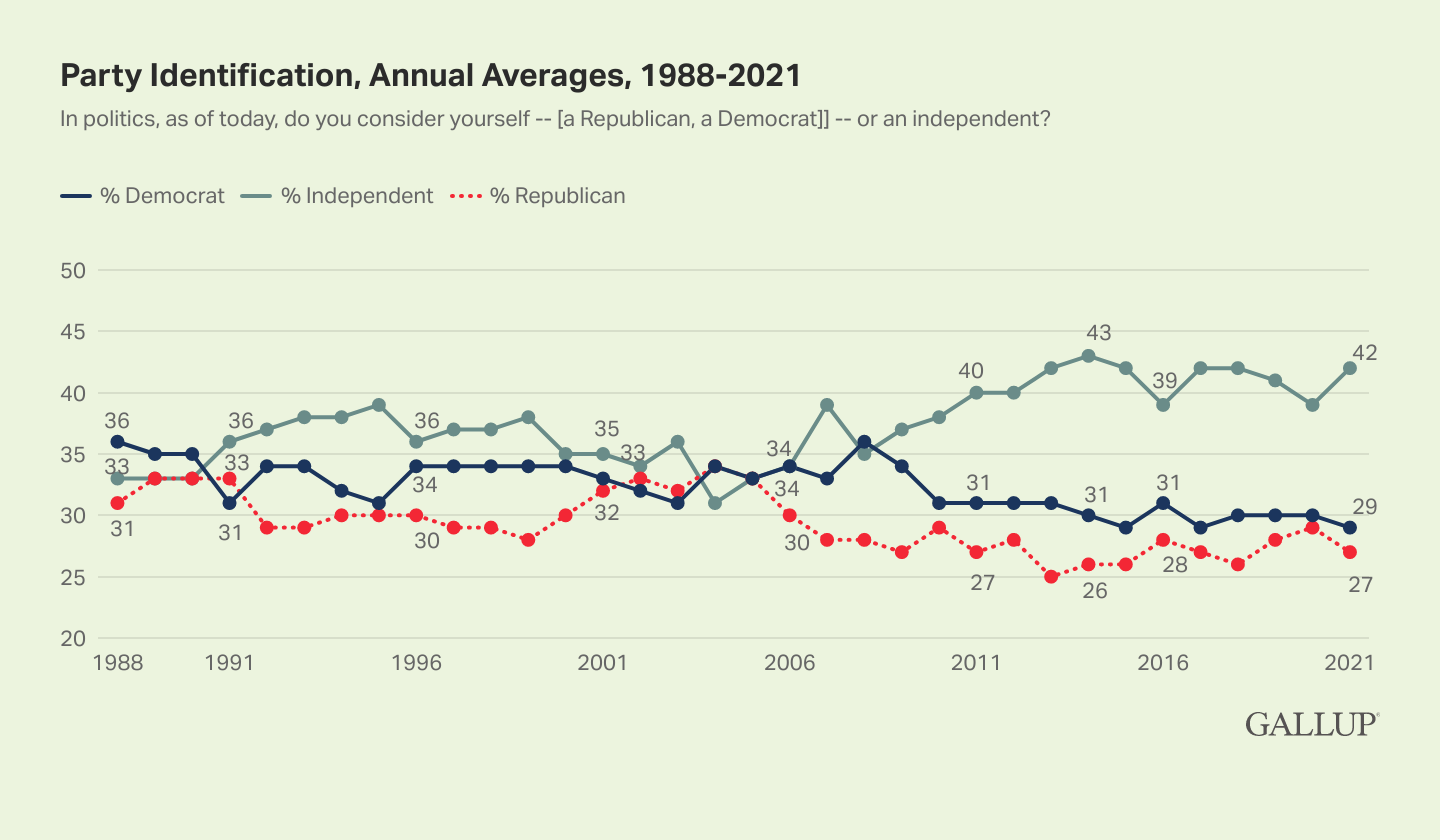What Percentage Of Voters Ages 7279 Are Registered Democrats
Story Highlights
- Preferences shifted from nine-indicate Democratic advantage to five-signal GOP border
- Average political party preferences for all of 2021 similar to past years
- Largest percentage of U.S. adults place equally political independents
WASHINGTON, D.C. -- On average, Americans' political party preferences in 2021 looked like to prior years, with slightly more U.S. adults identifying as Democrats or leaning Autonomous (46%) than identified equally Republicans or leaned Republican (43%).
However, the general stability for the full-twelvemonth boilerplate obscures a dramatic shift over the grade of 2021, from a 9-percent-betoken Democratic reward in the first quarter to a rare 5-signal Republican border in the fourth quarter.

Line graph. Quarterly averages of U.S. party identification and leaning in 2021. In the first quarter of 2021, 49% of U.S. adults identified every bit Democrats or leaned Democratic, while twoscore% identified as Republicans or leaned Republican. In the second quarter, 49% were Democrats or Autonomous leaners, and 43% were Republicans and Republican leaners. In the third quarter, 45% were Democrats and Democratic leaners, and were 44% Republicans and Republican leaners. In the 4th quarter, 42% were Democrats and Democratic leaners, and 47% were Republicans and Republican leaners.
These results are based on aggregated data from all U.Due south. Gallup phone surveys in 2021, which included interviews with more than than 12,000 randomly sampled U.S. adults.
Gallup asks all Americans it interviews whether they identify politically as a Republican, a Democrat or an independent. Independents are so asked whether they lean more than toward the Republican or Autonomous Party. The combined percentage of party identifiers and leaners gives a measure of the relative strength of the two parties politically.
Both the nine-point Democratic reward in the outset quarter and the 5-indicate Republican edge in the fourth quarter are among the largest Gallup has measured for each party in any quarter since information technology began regularly measuring party identification and leaning in 1991.
-
The Democratic lead in the kickoff quarter was the largest for the political party since the fourth quarter of 2012, when Democrats also had a ix-point advantage. Democrats held larger, double-digit advantages in isolated quarters between 1992 and 1999 and nearly continuously between mid-2006 and early on 2009.
-
The GOP has held as much equally a v-signal advantage in a total of only four quarters since 1991. The Republicans last held a v-point advantage in political party identification and leaning in early 1995, after winning control of the Firm of Representatives for the first fourth dimension since the 1950s. Republicans had a larger reward only in the first quarter of 1991, after the U.South. victory in the Persian Gulf State of war led by then-President George H.W. Bush.
Party Preference Shifts Follow Changes in Presidential Approval
Shifting political party preferences in 2021 are probable tied to changes in popularity of the two men who served as president during the year. Republican Donald Trump finished out his single term in January, after beingness defeated in the 2020 ballot, with a 34% task approving rating, the everyman of his term. His popularity fell more than 10 points from Election Day 2020 as the land's COVID-19 infections and deaths reached and so-tape highs, he refused to acknowledge the consequence of the ballot, and his supporters rioted at the U.South. Capitol on Jan. half dozen, 2021, in an attempt to prevent Congress from counting the 2020 Electoral College votes.
Democrat Joe Biden enjoyed relatively high ratings later on taking office on Jan. 20, and his blessing stayed loftier through the early summer equally COVID-nineteen infections dramatically decreased after millions of Americans got vaccinated against the affliction. A summer surge of infections tied to the delta variant of the coronavirus made information technology articulate the pandemic was non over in the U.S., and Biden's approval ratings began to sag. Afterwards, the chaotic U.Southward. withdrawal from Afghanistan caused Biden's ratings to fall farther, into the low 40s. His ratings remain low as the U.South. battles rising inflation and withal some other surge of COVID-nineteen infections, tied to the omicron variant of the virus.
With Trump's approval rating at a low bespeak and Biden relatively popular in the first quarter, 49% of Americans identified every bit Democrats or leaned Democratic, compared with 40% who were Republicans or Republican leaners.
In the second quarter, Autonomous affiliation stayed loftier, while Republican affiliation began to recover, increasing to 43%.
The tertiary quarter saw a decline in Democratic identification and leaning, from 49% to 45%, every bit Biden's ratings began to stammer, while there was no meaningful change in Republican amalgamation.
In the fourth quarter, party support flipped as Republicans made gains, from 44% to 47%, and Autonomous affiliation brutal from 45% to 42%. These quaternary-quarter shifts coincided with strong GOP performances in 2021 elections, including a Republican victory in the Virginia gubernatorial ballot and a near-upset of the Democratic incumbent governor in New Bailiwick of jersey. Biden won both states past double digits in the 2020 election.
The GOP advantage may be starting to ease, notwithstanding, as Gallup's latest monthly estimate, from December, showed the two parties about even -- 46% Republican/Republican leaning and 44% Autonomous/Democratic leaning.
2021 Shifts Occurred Among Both Core Party Identifiers and Less Attached Leaners
The shifts in party affiliation in each quarter of 2021 were apparent in both the percentage identifying with each party and the percentage of independents leaning to each party, but with more changes amidst leaners than identifiers.
Between the first and fourth quarters, the percentage of Democratic identifiers decreased by two points, while the percentage of Democratic-leaning independents dropped five points. Republican identification increased by three points from the beginning to the end of 2021, while Republican leaners increased by four points.
Changes in Party Identification and Leaning, by Quarter, 2021
In politics, equally of today, exercise you lot consider yourself -- [a Republican, a Democrat] -- or an independent? // As of today, do you lean more to the -- [Democratic Party or the Republican Party]?
| 2021-I | 2021-Ii | 2021-III | 2021-IV | |
|---|---|---|---|---|
| % | % | % | % | |
| Democrat | 30 | 31 | 28 | 28 |
| Democratic-leaning independent | xix | eighteen | 17 | fourteen |
| Not-leaning independent | x | v | 8 | 9 |
| Republican-leaning independent | 15 | 17 | 16 | 19 |
| Republican | 25 | 26 | 28 | 28 |
| Percentage with no stance non shown | ||||
| Gallup | ||||
Democrats Usually Agree an Advantage, and Did So in 2021
When all the 2021 shifts are netted out, the Democrats' average iii-point advantage for the entirety of the yr is just slightly smaller than they had in recent years. Democrats held v- or six-point advantages in political party affiliation each year betwixt 2016 and 2020, and 3-signal edges in 2014 and 2015.
Gallup began regularly measuring party leaning in 1991, and in most years, significantly more Americans have identified as Democrats or every bit independents who lean Democratic than as Republicans or Republican leaners. The major exception was 1991, when Republicans held a 48% to 44% advantage in party identification and leaning. From 2001 through 2003 and in 2010 and 2011, the parties had roughly equal levels of back up.

Line graph. Yearly averages of U.S. party identification and leaning between 1991 and 2021. In most years, more Americans take identified as Democrats or leaned Democratic than have identified equally Republican or leaned Republican. Republicans had an advantage only in 1991, 48% to 44%. Democrats' largest advantage was in 2008, 52% to 40%.
Independents Are Still the Largest Political Group in the U.S.
Regardless of which party has an reward in party affiliation, over the past iii decades, presidential elections take generally been competitive, and party command of the U.S. House of Representatives and Senate has changed easily numerous times. This is partly because neither political party can merits a very high share of core supporters -- those who identify with the party -- every bit the largest proportion of Americans place initially as political independents.
Overall in 2021, an boilerplate of 29% of Americans identified as Democrats, 27% as Republicans and 42% every bit independents. Roughly equal proportions of independents leaned to the Democratic Party (17%) and to the Republican Party (16%).
The percent of contained identifiers is up from 39% in 2020, but like to the 41% measured in 2019. Gallup has often seen a decrease in independents in a presidential election year and an increment in the year subsequently.
The broader tendency toward an increasing share of political independents has been articulate over the past decade, with more Americans viewing themselves as independents than did and then in the late 1980s through 2000s. At least iv in 10 Americans have considered themselves independents in all years since 2011, except for the 2016 and 2020 presidential election years. Before 2011, independent identification had never reached 40%.

Line graph. Almanac averages in political party identification, 1988 through 2021. Since 1998, more Americans have typically identified equally Democrats than as Republicans. Over the past decade, independents accept significantly outnumbered supporters of either political party.
Bottom Line
The year 2021 was an eventful one in politics, after a similarly eventful 2020 that besides saw major shifts in party preferences. In early 2021, Democratic strength reached levels not seen in nearly a decade. Past the third quarter, those Autonomous gains evaporated equally Biden's job approving declined. The political winds continued to become more favorable to Republicans in the fourth quarter, giving the GOP an advantage over Democrats larger than whatever they had achieved in more than than 25 years.
The final monthly survey of 2021 showed the parties at roughly even forcefulness, although that all the same represents a departure from the historical norm of the Democratic Party'southward having at least a slight reward in party affiliation.
With control of the Firm of Representatives and Senate at stake in this year'south midterm elections, party preferences volition be a primal indicator of which party will be improve positioned to gain majorities in the adjacent session of Congress.
To stay up to date with the latest Gallup News insights and updates, follow us on Twitter .
Acquire more about how the Gallup Poll Social Series works.
What Percentage Of Voters Ages 7279 Are Registered Democrats,
Source: https://news.gallup.com/poll/388781/political-party-preferences-shifted-greatly-during-2021.aspx
Posted by: marrowabeatice.blogspot.com


0 Response to "What Percentage Of Voters Ages 7279 Are Registered Democrats"
Post a Comment